
RTLs : RTs with Leyland chassis
This page updated 10th May 2011.
|
Introduction.London Transport had for many years dual-sourced chassis from AEC and Leyland, and had good experiences with the latter in the prewar TDs and in the STDs. It was politically important too, that England's capital should be seen to be using Leyland as well as AEC products, especially in the lively export market. So when the post-war standard bus for London was proposed, a Leyland powered version was essential. If it could be made to fit the same bodies as the AEC version, so much the better.. and so the RTL was born.Outwardly most of them looked identical to the RTs except for the Leyland radiator, which was made in a special form to fit the same profile as the RT radiator. The front chassis hangers were more prominent on the Leylands too, necessitating the small cut-out at the foot of the cab front, that had not been there on the original RT3 roofbox bodies. The prototype: RTL 501 (Total 1)Introduced: June 1948Chassis: 7RT: Leyland PD2/1, 16ft 4in wheel-base, 6 cylinder 9.8 litre diesel with AEC transmission
Body: Park Royal type RT3: 56 seats (26 + 30), metal frames, 4 bays. RTL 501 was the prototype Leyland RT. Why 501? By the time it was delivered London had decided on 500 8-feet wide Leyland PD3s and was going to number the 7ft 6in wide RTLs upwards from 500. In the event the wide ones were numbered into a separate RTW series, and later RTLs were numbered into the 1-500 sequence.
The complete bus arrived back at Chiswick in May 1948,
and was allocated to nearby Turnham Green garage (V),
for duties on the 91, with Sundays on the 65.
The Metro-Cammells: RTL 551 -1000 (Total 450)Introduced: August 1949 - April 1950
Body: Metro-Cammell, type RT7: 56 seats (26 + 30), metal frames, 4 bays. London Transport had intended to give the entire first order of 1000 RTL bodies to Metro-Cammell, but actually they only did 450. The remainder of the order was completed by Park Royal. The Met-Camms were almost standard RT bodies, very similar to the RT8 bodies. "Almost" meant that they were not interchangeable* with the RT3 and RT8 bodies, and so they were typed RT7. They were recognizable from the standard bodies by a thicker beading above the cream stripe, which had the visual effect of narrowing the stripe. * The body fixings for the RT7 prevented their being exchanged with RT8 bodies, and normally the 551-1000 numbers were kept for the MCCW buses, but a clerical error in January 1962 resulted in a Park Royal RT8 body receiving an RT7 batch fleet number after overhaul (RTL 626). This left the MCCW body in the Aldenham body float, which eventually came out with fleet number RTL 1005, in October 1963. Metro-Cammell-bodied RTL554 has been beautifully preserved in early livery. I came across it on a day-trip from York, at Newby Hall, in July 2004.The Park Royals: RTL 1 - 500, 502-550, 1001-1306, 1308-1600
|
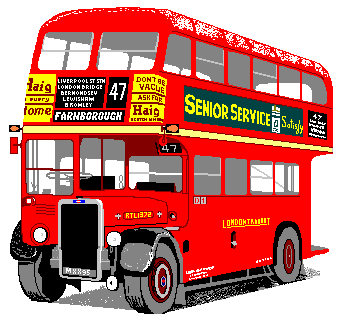
 RTL 501 had a Park Royal RT3 body with a roofbox.
The chassis, a PD2 reshaped to fit the standard RT bodies,
and fitted with RT-type air brakes and an AEC transmission,
was delivered to Chiswick in February 1948.
LT had been going to fit it with a Metro-Cammell body, but this order had not been finalised,
so it went instead to Park Royal to have a RT body fitted.
This body had been intended for RT657, (as had its registration number: JXC 20).
RTL 501 had a Park Royal RT3 body with a roofbox.
The chassis, a PD2 reshaped to fit the standard RT bodies,
and fitted with RT-type air brakes and an AEC transmission,
was delivered to Chiswick in February 1948.
LT had been going to fit it with a Metro-Cammell body, but this order had not been finalised,
so it went instead to Park Royal to have a RT body fitted.
This body had been intended for RT657, (as had its registration number: JXC 20).
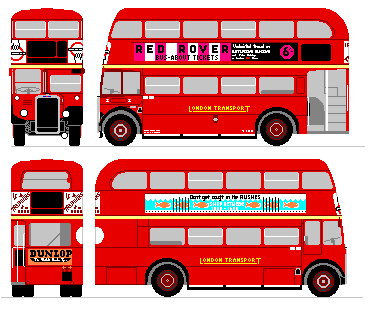


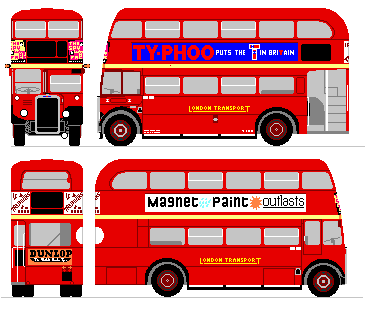 Introduced: June 1948
Introduced: June 1948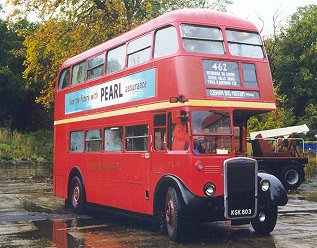
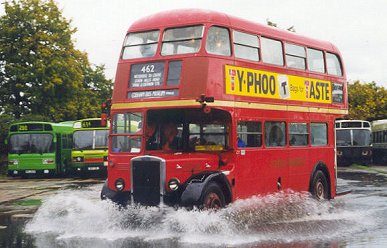
 Part Two: into service
Part Two: into service Ian's Bus Stop
Ian's Bus Stop RT Contents
RT Contents standard RTs
standard RTs